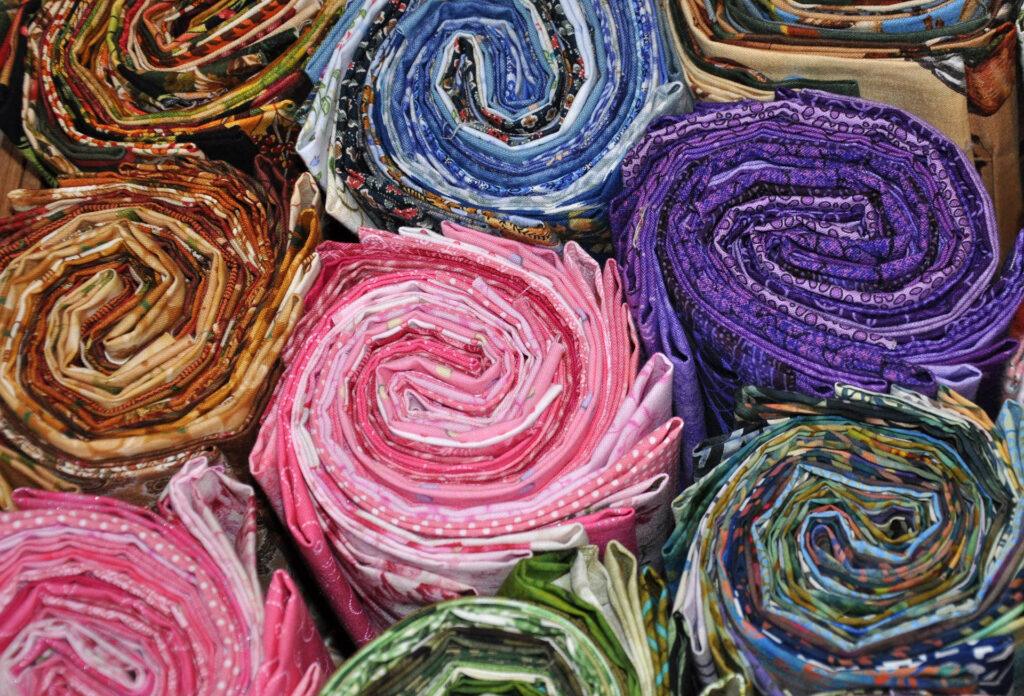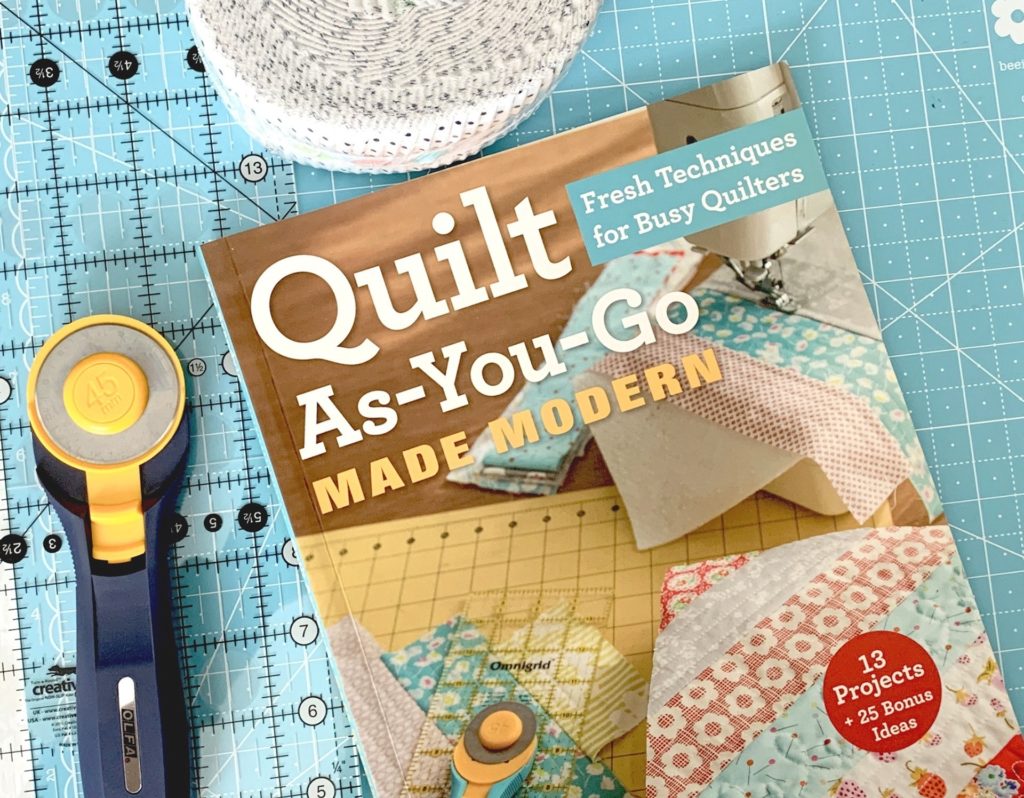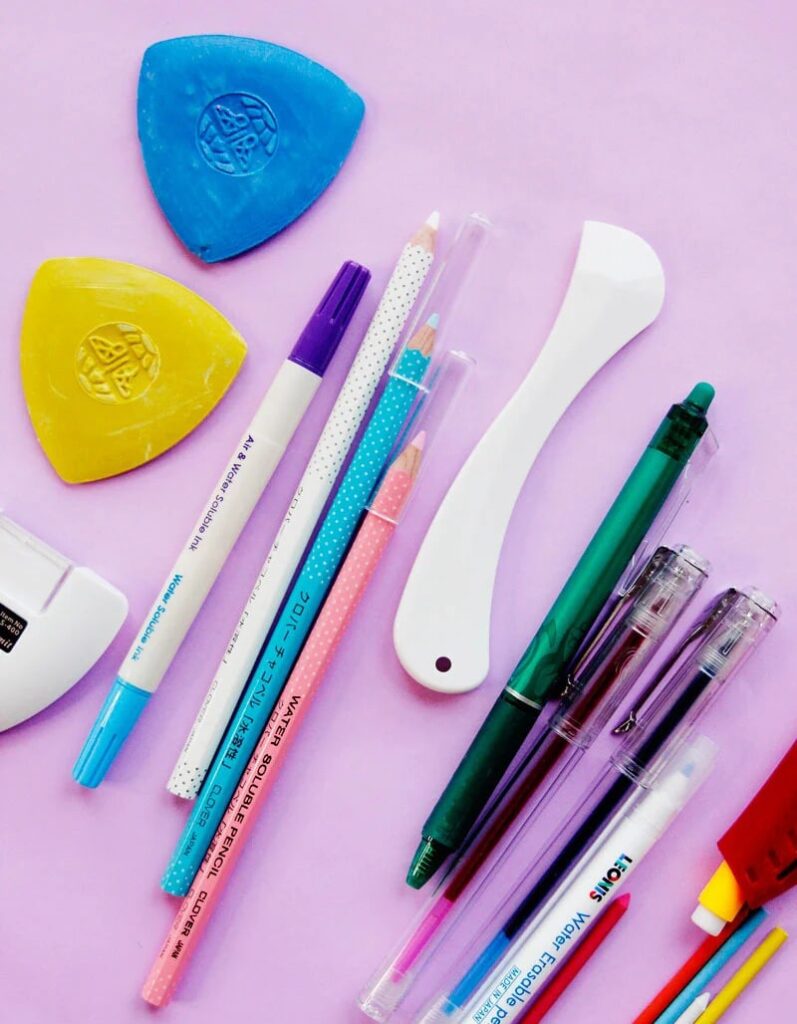

Quilting is a craft loved by many for all the right reasons. They can be used to make wonderful memories of clothes once worn or treasured in the past. Putting a quilt together takes a good amount of time, therefore, its binding should be done carefully and beautifully to complement the great work. Binding should be the final step. This means you have to quilt your quilt by attaching the front and back with batting. You can choose to hand quilt Trusted Source Hand-Quilting Basics | AllPeopleQuilt.com Hand quilting results in dashed lines of stitches and a quilt with a soft look. Methods of hand quilting vary as much as quilters do. Adapt the techniques that follow to suit your style. www.allpeoplequilt.com or machine quilt Trusted Source Machine Quilting Tips and Tricks - dummies If you have chosen to machine quilt your project, you need to prepare your machine for the chore at hand. Each machine quilting technique requires a different type of presser foot and machine setting, so read through the following information carefully. www.dummies.com .
Most people love quilting but struggle with binding. Essentially, binding is just finishing your quilt with a durable edging. It simply involves sewing a strip of fabric around the raw edges of a quilt to protect them from wear and tear. There are so many ways to go about it and none of them is right or wrong. Read on for more details on how to bind a quilt to achieve a very clean and polished finish to all of your projects.
The tools needed for quilt binding aren’t that many. You only need the quilt itself, binding fabric, a rotary cutter, or acrylic ruler, a self-healing cutting mat, and the sewing machine or hand stitching tools like a needle and thread for attaching the binding to the quilt.
The type of thread you use doesn’t have to be similar to the type of fabric you used to make your quilt. Just because your quilt is made of cotton doesn’t mean you have to use cotton thread for binding. You can use polyester thread which blends into different types of fabric well. Just ensure the thread you use for binding is a bit heavier than the regular sewing thread for a more invisible finish.
You will also need quilt pins and a walking foot if you are using a sewing machine to attach the binding. A walking foot sounds bulky for such a task, but it is the best because it is easy to use and attach. Its main advantage is that it reduces wrinkles and puckering in your quilt as it walks over the fabric.
If you don’t have a sewing machine and you’re wondering what to get from the pool of options out there, check out the highly acclaimed Juki HZL-F600 Computerized Sewing and Quilting Machine. It is simple to use, thanks to its user-friendly features like an automatic needle threader and an intuitive LCD screen. Also, it comes with loads of accessories that make it incredibly versatile.
As for quilting pins, the Clover Q2509 Quilting Pins remain the most popular option among professionals. They are a top preference for many because their pin heads are made of iron proof glass. You would have to remove them before ironing. They also have a thin sharp tip that easily passes through various types of fabric.

There are 3 necessary steps to quilt binding by machine and they include:
Contrary to popular opinion, you can finish quilt binding by machine. Most quilters claim that finishing a quilt binding by hand yields the best results. It is somehow true for the extra-special heirloom quality quilts that you would want to last forever or take to a quilt competition show. For the quilt you intend to use on the daily on your bed and drag around your house, you can do machine binding. It is more convenient and faster. You’d be done in a day.
This is a crucial step because it prepares the edges of the quilt to be stable and easy to stitch the binding along its edges. Especially if you are using tricky fabrics like Mink. You can do this by stitching a victory lap around the quilt to stabilize its edges.
After successful stitching of the victory lap, you need to cut the edge of your quilt square and straight. The corners should be sharp and neat at 90 degrees.
If your quilt is for displaying on your walls or in a quilting competition, then you might want to block it before binding as well. Blocking will manipulate it into the right shape and size as the quilting process tends to distort the fabric used by causing wrinkles. Blocking will make a whole difference on your quilt’s finishing.
The whole preparation sounds like a chore on its own but you should breeze through it if you setup your sewing machine right.
This process mainly involves making enough binding to attach to the entire length of the outside edges of your quilt. The measurements for cutting and making the binding will depend on the binding style you will be using. For instance, for the most common style, single fold binding, you will need to cut 1 ¼ inch wide strips. For double fold binding, you will need to cut 2-inch wide strips because the fabric is folded in half.
You can use a rotary cutter or acrylic ruler to cut strips of fabric along the width. If you are using striped or geometric fabric, be keen on cutting correctly to avoid stripes or checks that look crooked.
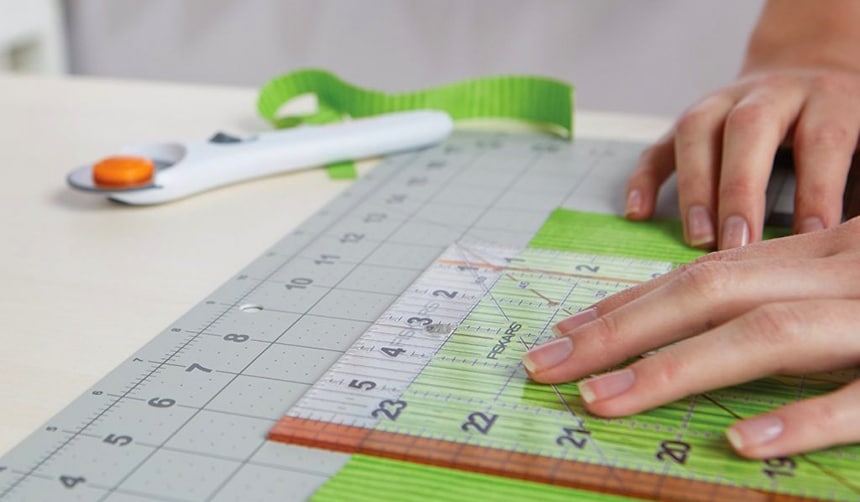
Once you have cut enough length, you can join the strips together on the diagonal. Joining them on the diagonal reduces bulk on the seam when folded on the quilt’s edge. You can also choose to do a straight joint, especially if you are doing a scrappy binding.
Place 2 strips of the binding fabric with the right sides together and perpendicular to each other. Ensure they are overlapping the fabric edges a little for you to see where the fabric edges are on both pieces of fabric. While doing this, ensure the prints or geometric patterns on your fabric are neatly aligned. If the prints are directional ensure they are facing the same direction when you stitch them together. If they are geometric, try to join the same part of the patterns together. This plays a huge role in hiding the seam.
Use an erasable marker to draw a diagonal line from the edge of one strip of fabric to the edge of the other fabric. Pin them together then sew along the line. You will end up with a corner. Trim it off then leave about a ¼-inch seam allowance. Open the seam and press it flat.
Repeat the process until you get enough length of the joined strips to go round the quilt’s edge. Fold the fabric in half along its length then press it to make the binding.
Now it’s time to attach the binding to the quilt. Attach it to the front of your quilt leaving a ¼-inch seam allowance. Begin at the center of the quilt’s bottom edge. This gives you a diagonal seam that will match your other strip joining seams. It also reduces bulk big time. You can as well choose to do a straight edge seam especially if your binding strip has 2 or more different prints.
Next, create a point at one end of the binding then open it and fold its right corner to meet the left hand edge. This should give the binding a point on the open edge of the fabric. Fold the binding again and press it well.
Lay the binding along the quilt’s bottom edge then pin it in place. Ensure the binding’s raw edges and the quilt line up. Sew the binding down. Your stitching should be about 6 inches from the tip of the binding point.
Sew up to the corner then stop at about ¼-inch from the fabric’s edge. You can position your needle at the ¼-inch point for an accurate stop. Once at the corner, pivot your needle then sew directly into your quilt’s corner. Grab a pair of scissors and trim threads before removing the quilt from the machine.
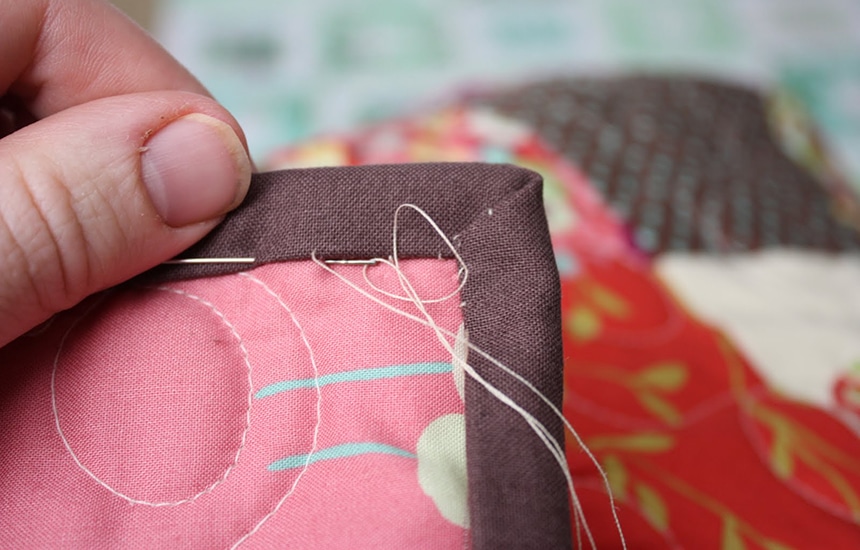
The next step is to mitre the corner. All you have to do is fold the binding straight up so that it makes a diagonal fold on top of the diagonal stitch you just made in the corner. Press the fold with your finger then fold the binding back down so that the top fold aligns with the edge of the quilt. Pin down the binding then sew it at ¼-inch from the top. Repeat the mitring process at the corner and sew until you find yourself at the side where you started the binding.
Stop stitching a few inches before you reach the pointed tip on the opposite end of the binding. If you allow yourself more space, you will have a lot of wriggle room. Fold the pointed end of the binding’s beginning out of the way then place the rest of the binding strip along the quilt’s edge. If it’s too long, overlap the pointed tail on top then place a pin on the right side to mark the where the tip of the binding point sits.
Open the pointed tail and turn it to align its right side perpendicular to the binding. The 2 binding edges need to meet. You can fold the quilt to make it easier. Line up the top edge to position the point exactly where the pin is in the binding. Remove the pin then use it to pin the 2 strips of fabric together.
The fold line you make on the binding acts as a seam marker. Sew the fabric along this fold line while keeping the quilt folded and the binding pulled away from its edge. Remove all the pins from the binding and check to see that it is not too loose. If you find it loose, you can adjust the seam to make it firmer. Trim off the extra fabric on the side of the seam then press the seam open with your finger.
At this point, when you lay the quilt flat, the binding joint should sit neatly down its edge. Press the flat then sew the remaining part of the binding seam.
Lastly, press and fold the binding to the quilt’s back then pin it in place. Fold the mitrid corners carefully then proceed to finish it by hand or machine.
You can choose to finish your quilt binding with a machine or by hand stitching. Hand stitching gives the most appealing results. If you are taking your quilt to a quilting competition or you want to hang it on your walls, finish by hand stitching.
Using a machine is quick and gives instant results, but your fabric and stitches won’t turn out as appealing as when hand stitched.
For hand stitching you can use a blind hem stitch. All you have to do is thread a fine and long needle with a 20-inch long thread then knot its end. Ensure the knot is hidden on the underside of the binding when you begin to sew. Bring up the thread through the binding at a point very close to the edge then sew a very small stitch before inserting the needle and bringing the thread up again. Repeat the process until you sew all the remaining parts.
Using a sewing machine is pretty straightforward. You only need to select a hem stitch on the machine and start sewing all the remainder bits of the binding.
Single and double fold binding are the most common quilt binding techniques. When choosing a quilt binding technique, you must consider the size and the needs of your project. Single fold binding involves the use of a single, flat strip of fabric which is great for small projects. It is perfect for small projects because it is only a single layer of fabric binding attached to the raw fabric edge. It reduces bulk which any quilter would want to avoid with a small project.
The double fold binding, on the other hand, is a strip of fabric that has been folded in half. It is much easier to achieve and it neatly protects the raw edges of your quilt in a double layer. It is perfect for large projects but can also be used on small projects. If you don’t mind a bit of bulk on your small project, you can do a double fold binding.
If you choose to bind the edges of your quilt with straight edges or corners, then you better use fabric binding strips cut from the straight grain across your fabric’s width.
On the other hand, if you are working on a project that has curved or scalloped edges, then your binding fabric should be able to stretch around the curves. You can, therefore, cut your fabric binding strips at a 45 degrees angle to the straight grain. You will require a lot of fabric for this and you might end up with a lot of wastage and left-overs as well.
The rule of thumb when it comes to binding fabric choice, is that you use any material that has the same weight and composition as the quilt. If your quilt is made of cotton, you should use cotton of the same weight to bind. However, at the end of the day it’s a matter of personal preference and what you’d like to achieve. The material you choose depends on the final look that you want to achieve and how long you want it to last.
Traditionally, quilt binding is done with the same fabric for the entire length. In the present day, you can get creative and do a scrappy look by creating a patchwork of different fabric strips. Also, you can simply create a contrasting detail by adding a single piece of contrasting fabric.
If you are using the regular ¼-inch seam allowance, the ideal width for your quilt binding strips should be about 2 to 2 ½ inches. You can choose to make it wider if you love the larger binding than the standard ¼ inch seam allowance. It comes down to personal preference.
First off, you need to find the perimeter of the quilt by measuring the length and width of your quilt. Multiply each of the measurements by 2 then add them together. Add 10 inches to the results for the overlap. The next step is calculating the number of binding strips you will need for the project. Establish the width of the fabric then divide the perimeter plus the overlap 10 inches by the width. Round up the results to a whole number. For instance if your results are 2.2 round up to 3.
The third step is determining the amount of fabric you will need for the project. Decide how wide you need the strips to be then multiply it by the number of strips you need. Convert the results you get into yards.
Quilt binding is dreaded by many, even some skilled quilters finish their quilts themselves then source them out for binding. With the right tools and materials, anyone can bind their quilts beautifully to end up with gorgeous pieces worth displaying. You can choose to quilt bind with a machine or by hand. For the most gorgeous finishes, you can put in the time and use your hands. The stitches would be more detailed as compared to the easy and fast machine quilt binding.
As with any other craft, practice makes perfect. You also need to educate yourself on how to bind a quilt by watching tutorials and reading the best quilting books. The more quilts you bind, the more you will become adept at the craft. Quilting and binding go together like sugar and cinnamon. You shouldn’t be good at one and suck at the other.

